An Alfa Romeo GTV6 Is the Unlikeliest Safari Rig
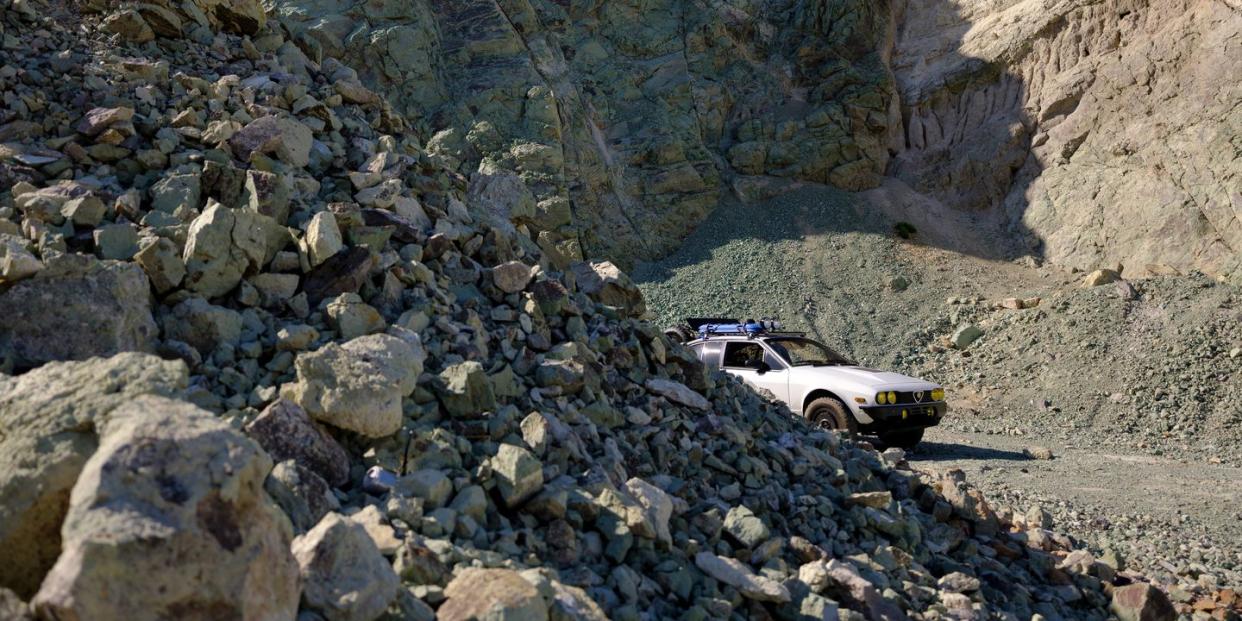
A Jeep Wrangler Rubicon can take you almost anywhere, except the desert ridge I’m pogoing across. This 1985 Alfa Romeo GTV6 is a foot narrower than Mopar’s billy goat and only an inch wider than a Polaris side-by-side. That’s why I accidentally drove up an ATV trail. There isn’t much signage in the Jawbone Canyon OHV area, and the map has so little detail that the California park’s ink budget must be hundreds of cents. I climbed the first hill easily, the heavy spare tires and transaxle pressing the two driven wheels into the sand, but now I’m on a section that’s turned the car into a supermarket horse. When the spare tires crash down onto the custom hatch a fourth time, I realize my error, come to a stop, and sheepishly reverse down. This Safari Alfa is capable, but not that capable.
This story originally appeared in Volume 6 of Road & Track.
SIGN UP FOR THE TRACK CLUB BY R&T FOR MORE EXCLUSIVE STORIES
Safari builds are a mashup between rally car and overlander. The name comes from one of the more grueling motorsports events ever created: the East African Coronation Rally (later known as the Safari Rally), a 3000-mile race across Kenya first held in 1953. Its attrition rate has sometimes exceeded 90 percent.
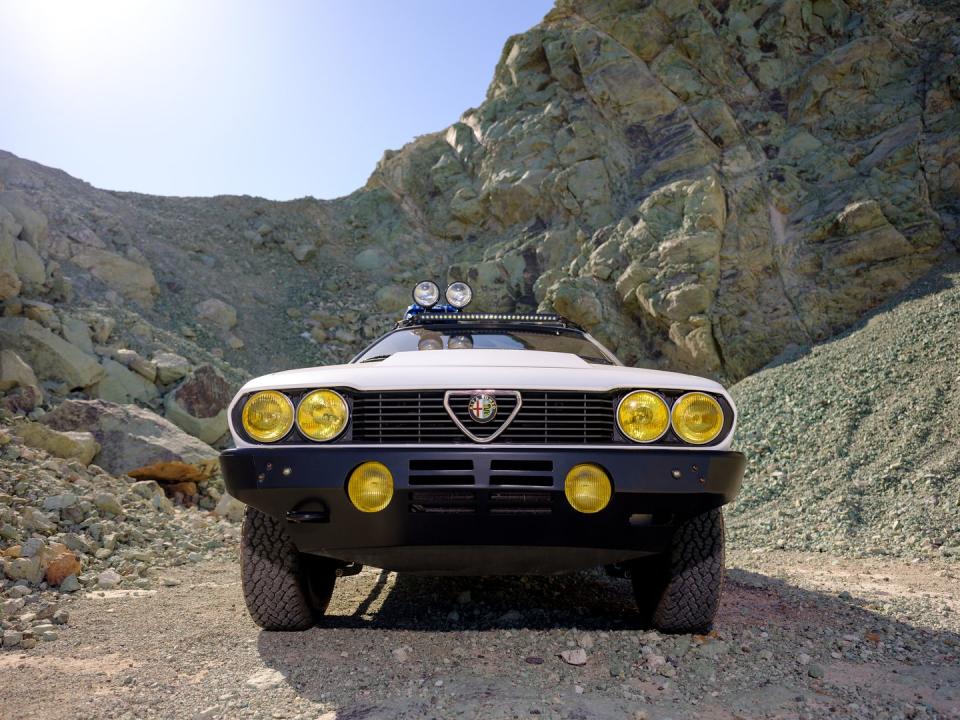
The recent Safari trend is led by people in the Porsche community like film director Jeff Zwart and racing driver Leh Keen. Zwart built a rally 911 tribute, which inspired Keen to do the same. Keen grew up loving two things: racing 911s and exploring Georgia’s dirt roads. Combine them and you get a Safari 911. Keen’s car was so good that he built and sold 25 more. What’s the key to a good Safari? Keen says it requires “some well-thought-out engineering and a good balance. Balance of suspension, power, chassis, ride height. Not overdoing it in one area.”
Specifications
1985 Alfa Romeo GTV 6/2.5 Safari
Price:
$45,000 (est.)
Engine:
2.5-liter V-6
Output:
154 hp @ 5500 rpm
152 lb-ft @ 3200 rpm
Curb weight:
3123 lb (est.)
0–60 mph:
10.0 seconds (est.)
At first glance, the Alfa fit the bill. It was designed by Oil Stain Lab, a boutique automotive design consultant, and assembled by a team of L.A.’s finest fabricators. It was commissioned as a marketing vehicle for the outdoor apparel company Aether. Judging by the number of people that asked about the car at every stop, it’s working. Who would have thought that a Giugiaro two-door would look great in hiking boots?
I’ve crossed various parts of the U.S. on roads of dirt and rock in vehicles that are rarely found near either. It’s immense fun. But I’ve never done it in an old Alfa. I packed many tools.
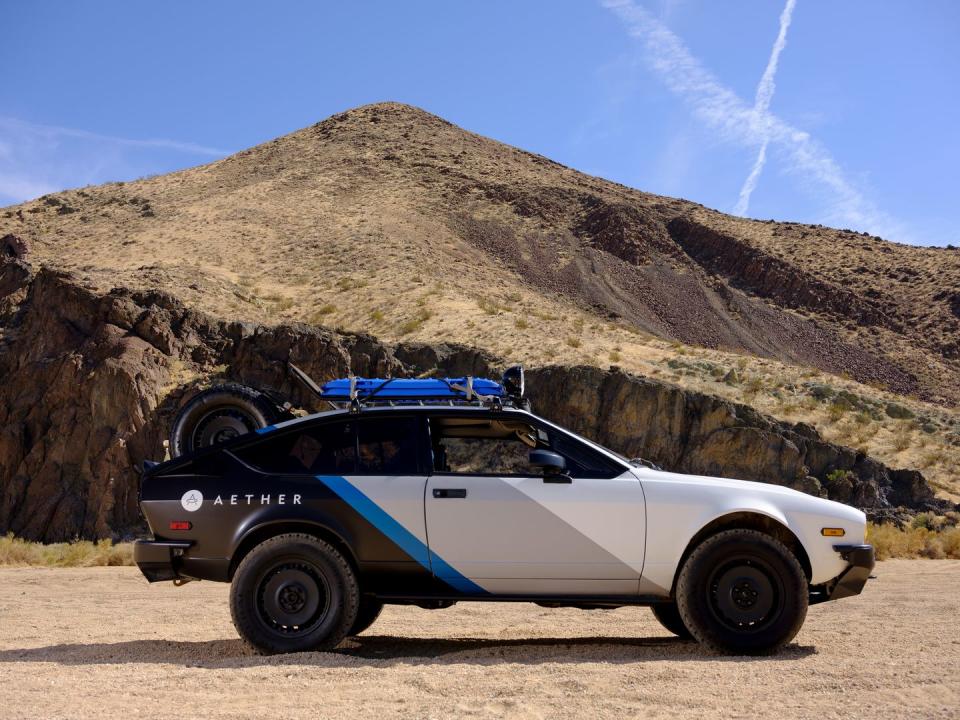
Jawbone Canyon is named after the remains of the last person who drove an Italian sports car into it. The nearest repair shop is 30 miles away. It services tractor-trailers. The nearest foreign auto repair is 50 miles away with a Yelp page full of modern German metal. I mentally prepared to sleep in the desert. Were my fears warranted? A friend and former Alfa mechanic told me the cars are “wonderful as long as you drive like they’re made of paper.” I laughed. He didn’t.
Despite having tires, fuel cans, and added lights, the original Giugiaro-designed beauty is maintained. In fact, the new hatch improves the rear half. Nikita Bridan—a former designer at Honda, Hyundai, and GM, and co-founder of Oil Stain Lab—said the intent of the redesigned hatch was “about retaining the silhouette of the car. But it also had performance benefits, moving weight off the roof, lowering the center of gravity, and moving weight over the rear wheels for improved traction.”
A Safari build needs heaps of ground clearance. Rock beats paper. Bridan tapped Scarbo Performance to design the suspension, which now has coils all around. Then Flying Dutchman Industries added bash bars, a skid plate, and a roll cage, and went through the car front to back.
The engine, left stock, fires immediately on a turn of the key. The 2.5-liter V-6 feels smooth enough to pass for an inline unit from Bavaria. Shifting the five-speed transmission is vague, like using a butter knife to find a penny in a jar of jam. Double-clutch from first to second or the gears form a noisy picket line.
I got to know the Alfa on the two-hour drive to Jawbone. Besides the roll cage, a stereo, and a few switches, the interior is stock. Old Italian cars are ergonomic enigmas. The pedals seem to be migrating to the passenger footwell, and the steering wheel blocks the speedometer between 20 and 120 mph, only one of which is attainable. The front windows roll up at unequal rates, although both could be described as “slow.”
At idle the car sounds like a bird sanctuary. There’s chirping from the transaxle, a vibration at the midpipe, and an inconsistent flutter coming from the front. Highway speeds are a reminder of how great sound deadening is and what a shame it is that Alfa Romeo didn’t have any.
But the steering is excellent. Unassisted, talkative, with zero slop off center. Brakes? Solid. It leans in corners and the big, heavy tires are reluctant to change course, but the package feels tight.
Alfa Romeo’s racing history is littered with multiple touring car championships, but the brand also conquered the Group A World Rally Championship from 1983 to 1986. Those rallies were won in a GTV6. That’s what inspired this build.
“The real last fun place to drive is off-road,” Bridan tells me. “Today’s traffic and canyon runs have become overcrowded, and cars aren’t fun.”
He’s not wrong. Off-road, the GTV is a blast. It pitches, moves, and slides the way I imagine touring cars used to, except it all happens at 25 mph. Every turn, hill, or stop requires thought and planning. Watch for rocks, deep sand, and other motorists. Eyes and ears focus. Your body reads seat vibrations for messages of traction or slip. The car still feels a bit too stiff, but perfection is the enemy of good, and driving through the desert like you robbed a bank is very good indeed.
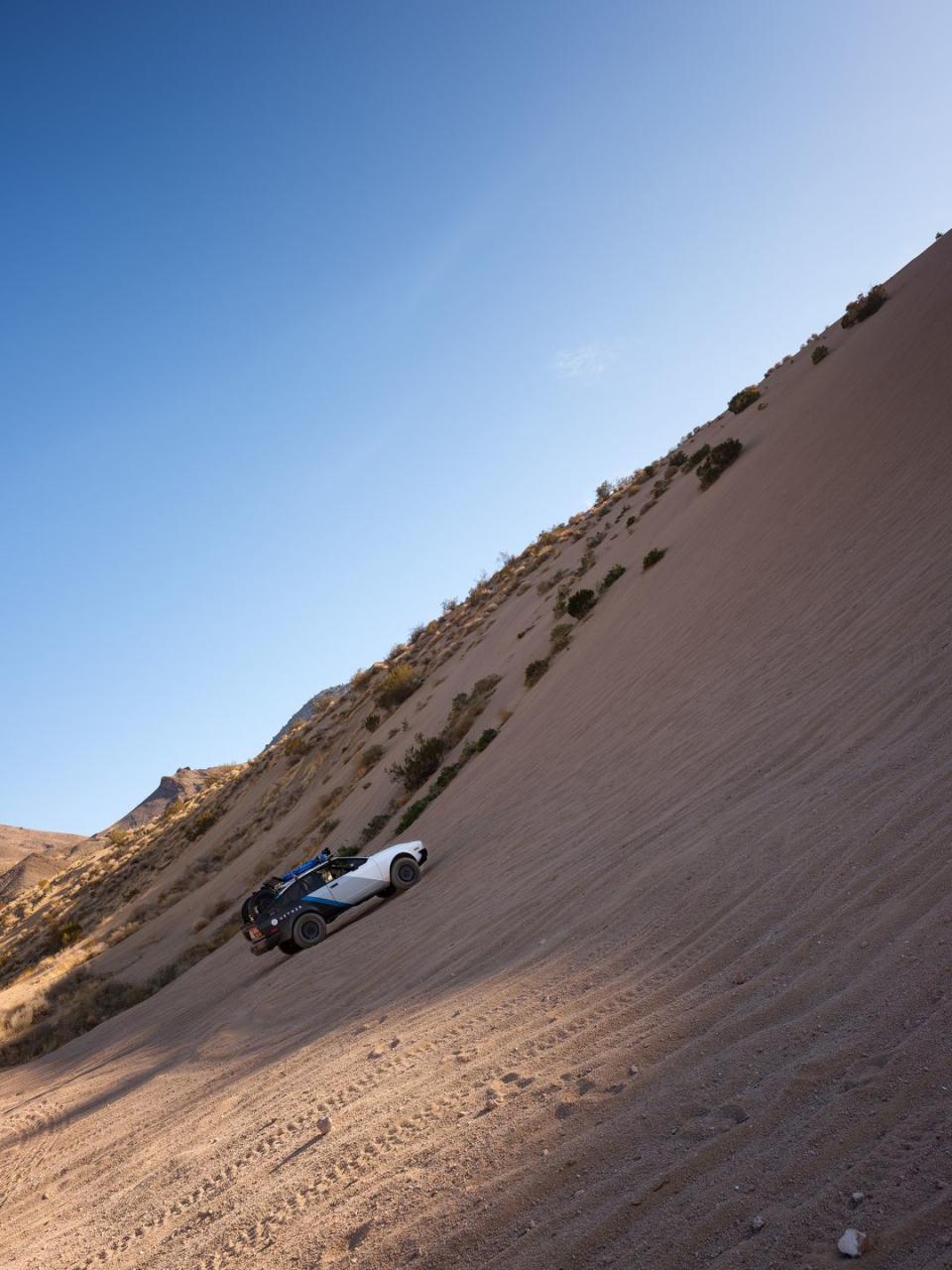
It’s not without other flaws: It’s slow. The bigger tires and metal tubing have turned a momentum car into a momentum locomotive. Despite the additional 6.5 inches of ground clearance, I cringe every time I pass over a rock. The rear suspension—a de Dion design with exposed inboard brakes and a large beam hanging below the diff—bangs against obstacles that the front skid plate easily clears. I choose my lines through the dirt as carefully as words in a failing relationship. It’s amazing fun. All I want to do is drive it to Nevada.
After a trouble-free day, the jacked-up Alfa cools under the desert moon, and I can’t stop smiling. Recently, there’s been an increasing amount of eye-rolling at Safari builds based solely on the trend’s prevalence. But popularity doesn’t determine value. “Three years from now there might be some other trend on social media,” Keen says. “But most of the owners don’t care about likes.” Give someone 20 minutes in a car like this Alfa and they’ll join the congregation.
A proper 4x4 could have easily followed the Alfa, but Safari cars aren’t about maximum capability. They’re about maximum enjoyment. Where a 4Runner sees a gravel road as an intermission between boulder fields, a Safari driver creates a rally stage.
There’s a sense of play and adventure about these creations that is almost nonexistent at a track day. A boldness possessed by the car, the builder, and the driver alike. I can’t fault Aether for building it. Outdoor clothing lets you see more of the world without freezing to death, and so do cars. As far as billboards go, it’s a good one.
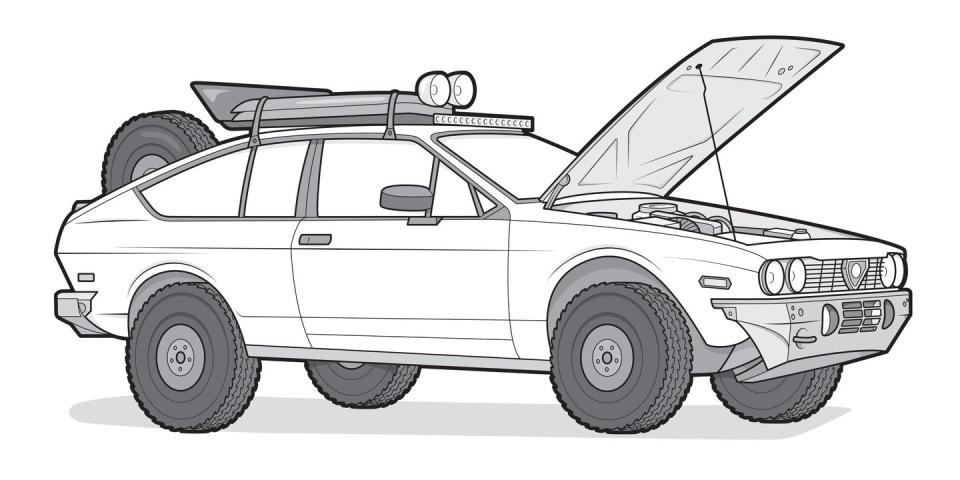
Keys to the Perfect Safari
1. Tires: The most important modification to any car—and especially important when you’re traveling down a dirt road littered with granite knives. The tread needs to be able to grip a variety of surfaces, and the sidewalls need to be thick enough to withstand scrapes. Off-road or rally tires are excellent, but if you’re on a budget, snow tires work. Get the tallest ones you can that don’t rub.
2. Ground clearance: The more clearance you have, the less likely you are to high-center, or worse, nick your oil pan and send dinosaur syrup back to whence it came. Don’t go too high or you’ll lose the playful handling, at which point you should just get a Jeep.
3. Reliability: This is directly proportional to how good a wrench you are. If your only tool kit fits in your pocket, you should start with the most reliable car you can. A good Safari provides predictable oversteer and the ability to see more than if you were traveling on foot. Mechanical issues get in the way of both.
You Might Also Like

